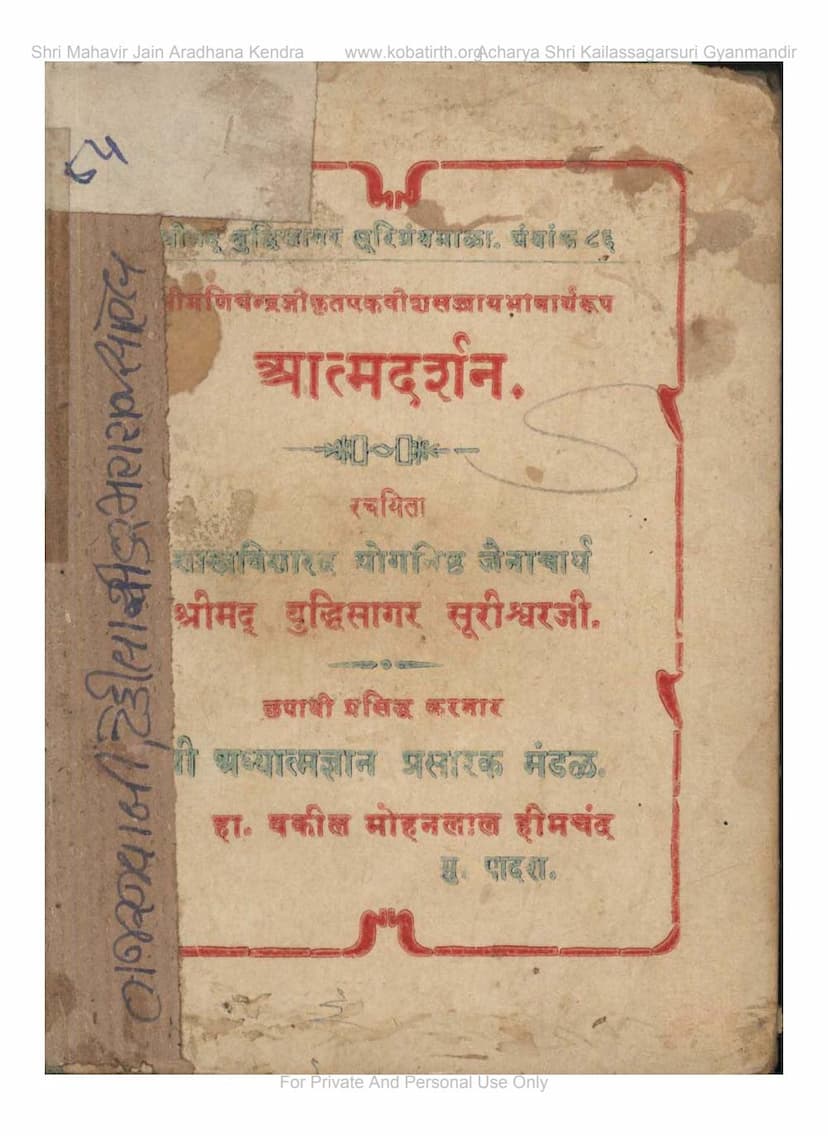Atmadarshan
Added to library: September 1, 2025

Summary
Here's a comprehensive summary of the Jain text "Atmadarshan" by Buddhisagar, based on the provided pages:
Book Title: Atmadarshan Author: Acharya Shrimad Buddhisagar Surishwarji Publisher: Adhyatma Gyan Prasarak Mandal Catalog Link: https://jainqq.org/explore/008527/1
Overall Purpose and Content:
"Atmadarshan" is a Jain spiritual text published in 1925 (Veer Samvat 2450) by the Adhyatma Gyan Prasarak Mandal. The book's core purpose is to guide spiritual seekers towards self-realization and the understanding of the true nature of the soul (Atma). It achieves this by providing an in-depth commentary on the "Ekveesh Sajhay" (Twenty-one devotional songs or verses) composed by the esteemed Jain ascetic, Shrimad Manichandraji.
Key Figures and Their Contributions:
- Shrimad Manichandraji: A highly realized and spiritually advanced Jain ascetic, known for his profound spiritual insights and detachment. He composed the "Ekveesh Sajhay," which are described as expressing deep spiritual longing, renunciation, and excellent discussions on Dravyanuyog (the philosophical aspect of Jainism). His verses are said to reflect the spiritual depth of other great Jain saints like Shrimad Anandghanji and Shrimad Devchandji. Despite suffering from a severe illness (leprosy), he maintained equanimity and spiritual absorption. The text also mentions a legend of a divine being praising his spiritual state and a conversation he had with a divine being, revealing details about the spiritual journeys of other prominent figures.
- Acharya Shrimad Buddhisagar Surishwarji: The author of "Atmadarshan," he is the commentator who provides an elaborate and accessible explanation of Manichandraji's "Sajhay." Recognizing the profound, yet often intricate, meaning within these verses, Buddhisagarji undertook the task of clarifying their spiritual essence for the benefit of a wider audience. His commentary is praised for its clarity and spiritual depth, making the profound teachings accessible to sincere seekers.
- Shri Mohanlal Himchand (Vakil): A prominent philanthropist and supporter of spiritual literature, he is acknowledged for his financial contribution of Rs. 200 towards the publication of this book, enabling its dissemination.
Structure and Key Themes:
The book primarily consists of:
-
The "Ekveesh Sajhay" by Shrimad Manichandraji: These are devotional verses that explore various aspects of the soul's journey, including:
- Navdha Bhakti (Nine Types of Devotion): The text meticulously explains each of the nine forms of devotion (Shrvan - listening, Kirtan - chanting, Sevan - service, Vandan - salutation, Ninda - self-criticism/renunciation of vices, Dhyan - meditation, Laghuta - humility, Ekta - oneness, Samata - equanimity). Each form is elaborated upon with its spiritual significance and how it leads to the purification and liberation of the soul.
- Self-Inquiry and Detachment: The verses and their commentary emphasize the importance of understanding the transient nature of the world and the body, fostering detachment from worldly pleasures and possessions.
- The True Nature of the Soul: A central theme is the exploration of the soul's inherent qualities like infinite knowledge, perception, bliss, and energy, and how to realize these through spiritual practice.
- Control of the Mind: The text highlights the challenges posed by the mind, its tendencies towards desires and distractions, and the importance of bringing it under control through spiritual discipline.
- The Path to Liberation (Moksha): Through the practice of devotion, meditation, and self-awareness, the verses guide the reader towards the ultimate goal of liberation from the cycle of birth and death.
-
Commentary by Shrimad Buddhisagarji: His detailed explanations bring out the subtle spiritual meanings, the yogic practices, and the philosophical underpinnings of Manichandraji's verses. He breaks down complex concepts into simpler terms, making them digestible for the common seeker.
-
Additional Content:
- Doha (Couplets) on Five Types of Anushthan (Practices): The book also includes commentary on five types of spiritual practices, categorized as Vish (poison), Garal (venom), Ananya (non-dual), Hetu (cause/purpose), and Amrit (nectar). The focus is on abandoning the first three and embracing the latter two for spiritual progress.
- Stavan (Praise) of Vasupujya Swami: A hymn praising Lord Vasupujya, the 12th Tirthankara, is also included, further enriching the devotional aspect of the book.
Key Teachings and Principles:
- The Soul is Paramount: The ultimate reality and source of true happiness lies within the soul. Worldly pursuits are temporary and ultimately lead to suffering.
- The Power of Devotion (Bhakti): The ninefold path of devotion is presented as a potent means to purify the soul and progress spiritually.
- Mindfulness and Self-Awareness: Constant introspection and control over the mind are crucial for spiritual advancement.
- Detachment and Renunciation: True happiness is found in letting go of desires and attachments to external objects and experiences.
- The Importance of the Guru: The guidance of a spiritual teacher is invaluable for understanding and practicing the spiritual path.
- The Goal of Moksha: The ultimate aim of spiritual life is liberation from the cycle of rebirth and the attainment of the soul's pure, omniscient, and blissful state.
- The Nature of Karma: The text implicitly discusses how actions (karma) influence one's spiritual journey and the importance of right action and contemplation to overcome karmic bondage.
Significance and Impact:
"Atmadarshan" serves as a vital resource for Jain spiritual aspirants. By making the profound teachings of Shrimad Manichandraji accessible through Buddhisagarji's commentary, it offers a clear roadmap for understanding the soul, practicing devotion, and ultimately achieving spiritual liberation. The book's publication was supported by philanthropic efforts, highlighting its value in disseminating spiritual knowledge.
In essence, "Atmadarshan" is a profound exploration of the Jain path to self-realization, presented through devotional poetry and insightful commentary, aiming to guide individuals towards inner peace and spiritual freedom.